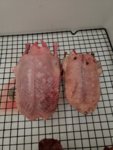Awesome post Robby. Thanks for posting this.
I've dry aged to about 14 days before. I need to push it further. Just a thought about the percentage of meat loss, the difference in weight may yield a difference of roughly 10% between aged and uncaged, bit after seeing what I did with my deer at 14 days, I'd guess close to 1/2 was simply the blood loss & moisture from the meat. Not actually volume of edible meat tissue.
Regarding the hair and dirt. I know everyone is always freaked out about getting meat wet. But the issue is blown out of proportion. Go into any butcher shop or slaughter house, that meat is getting hosed down regularly. I personally wash all my meat once its home, then it goes in the fridge or gets hung to let dry reasonably quickly. Getting it dry is the important part.
I personally also freeze and thaw meat up to a couple times and have never seen a degradation in quality. I think the trick there is to never allow it to warm to room temp. If it does, it gets cooked. I was reading on here about how freezing breaks the barriers of the cell walls and that's what give its poor texture. Taking that a step further, I froze and thawed all the meat that was reserved for grind several times this year. It was in a strainer in a bowl and it was amazing how much more blood I got out of that meat, for very little additional effort. Tasted much better without the blood in it.
Now to go see if my Strata will allow me to hang a deer in the underground parkade.

 . If you're doing a grind then absolutely be careful about contamination. We trim ours while it's hanging and rotate cutting boards as well.
. If you're doing a grind then absolutely be careful about contamination. We trim ours while it's hanging and rotate cutting boards as well.
